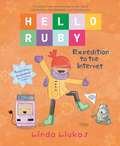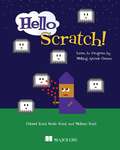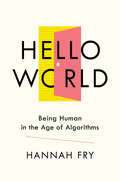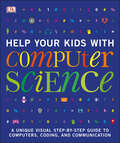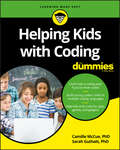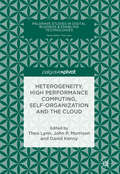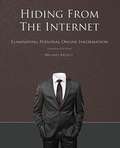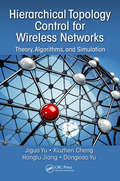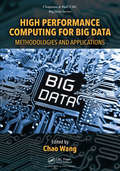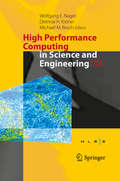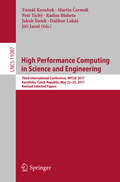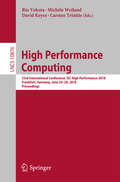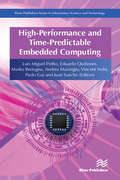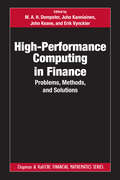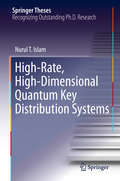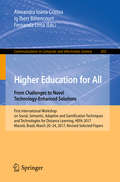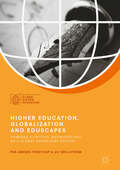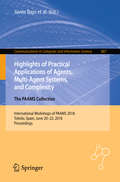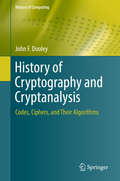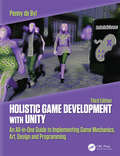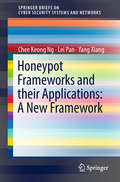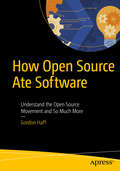- Table View
- List View
Hello Ruby: Expedition to the Internet (Hello Ruby #3)
by Linda LiukasWelcome back to the world's most whimsical way to learn about technology and coding in Hello Ruby: Expedition to the Internet, as Linda Liukas, a programming superstar, teaches kids all about the internet through storytelling and imaginative activities.What exactly is the Internet? Is it a cloud? A network of wires? How does the information travel online? Learn all this and more with Ruby!In Ruby’s world anything is possible if you put your mind to it—even building the Internet out of snow! But before you can build something, you need to understand what it is and how it works. Join Ruby and her friends in their quest to build the most amazing Snow Internet ever, while learning real life facts along the way. Then, future kid coders can put their knowledge and imaginations to the test with the fun and creative exercises included in the activity book section.
Hello Scratch!: Learn to program by making arcade games
by Melissa FordSummaryHello, Scratch! is a how-to book that helps parents and kids work together to learn programming skills by creating new versions of old retro-style arcade games with Scratch.Purchase of the print book includes a free eBook in PDF, Kindle, and ePub formats from Manning Publications.About the TechnologyCan 8-year-olds write computer programs? You bet they can! In Scratch, young coders use colorful blocks and a rich graphical environment to create programs. They can easily explore ideas like input and output, looping, branching, and conditionals. Scratch is a kid-friendly language created by MIT that is a safe and fun way to begin thinking like a programmer, without the complexity of a traditional programming language.About the BookHello Scratch! guides young readers through five exciting games to help them take their first steps in programming. They'll experiment with key ideas about how a computer program works and enjoy the satisfaction of immediate success. These carefully designed projects give readers plenty of room to explore by imagining, tinkering, and personalizing as they learn.What's InsideLearn by experimentationLearn to think like a programmerBuild five exciting, retro-style gamesVisualize the organization of a programAbout the ReadersWritten for kids 8-14. Perfect for independent learning or working with a parent or teacher.About the AuthorsKids know how kids learn. Sadie and Gabriel Ford, 12-year-old twins and a formidable art and coding team, wrote this book with editing help from their mother, author Melissa Ford!Table of ContentsPART 1 - SETTING UP THE ARCADEGetting to know your way around ScratchBecoming familiar with the Art EditorMeeting Scratch's key blocks through important coding conceptsPART 2 - TURNING ON THE MACHINESDesigning a two-player ball-and-paddle gameUsing conditionals to build a two-player ball-and-paddle gamePART 3 - CODING AND PLAYING GAMESDesigning a fixed shooterUsing conditionals to build your fixed shooterDesigning a one-player ball-and-paddle gameUsing variables to build your one-player ball-and-paddle gameDesigning a simple platformerUsing X and Y coordinates to make a simple platformerMaking a single-screen platformerUsing arrays and simulating gravity in a single-screen platformerBecoming a game maker
Hello World: Being Human in the Age of Algorithms
by Hannah FryShortlisted for the 2018 Royal Society Investment Science Book Prize A look inside the algorithms that are shaping our lives and the dilemmas they bring with them. If you were accused of a crime, who would you rather decide your sentence—a mathematically consistent algorithm incapable of empathy or a compassionate human judge prone to bias and error? What if you want to buy a driverless car and must choose between one programmed to save as many lives as possible and another that prioritizes the lives of its own passengers? And would you agree to share your family’s full medical history if you were told that it would help researchers find a cure for cancer? These are just some of the dilemmas that we are beginning to face as we approach the age of the algorithm, when it feels as if the machines reign supreme. Already, these lines of code are telling us what to watch, where to go, whom to date, and even whom to send to jail. But as we rely on algorithms to automate big, important decisions—in crime, justice, healthcare, transportation, and money—they raise questions about what we want our world to look like. What matters most: Helping doctors with diagnosis or preserving privacy? Protecting victims of crime or preventing innocent people being falsely accused? Hello World takes us on a tour through the good, the bad, and the downright ugly of the algorithms that surround us on a daily basis. Mathematician Hannah Fry reveals their inner workings, showing us how algorithms are written and implemented, and demonstrates the ways in which human bias can literally be written into the code. By weaving in relatable, real world stories with accessible explanations of the underlying mathematics that power algorithms, Hello World helps us to determine their power, expose their limitations, and examine whether they really are improvement on the human systems they replace.
Help Your Kids with Computer Science (DK Help Your Kids)
by DKFrom coding languages and hardware to cyberbullying and gaming, this comprehensive homework helper for kids and parents covers the essentials of computer science. This unique visual study guide examines the technical aspects of computers, such as how they function, the latest digital devices and software, and how the Internet works. It also builds the confidence of parents and kids when facing challenges such as staying safe online, digital etiquette, and how to navigate the potential pitfalls of social media. Jargon-free language helps to explain difficult and potentially dread-inducing homework such as hacking, "big data" and malware, while colorful graphics help makes learning about the world of computer science exciting. Whether at home or school, this clear and helpful guide to computer science is the tool you need to be able to support students with confidence. Series Overview: DK's bestselling Help Your Kids With series contains crystal-clear visual breakdowns of important subjects. Simple graphics and jargon-free text are key to making this series a user-friendly resource for frustrated parents who want to help their children get the most out of school.
Helping Kids with Coding For Dummies
by Camille McCue GuthalsHelp for grown-ups new to coding Getting a jump on learning how coding makes technology work is essential to prepare kids for the future. Unfortunately, many parents, teachers, and mentors didn't learn the unique logic and language of coding in school. Helping Kids with Coding For Dummies comes to the rescue. It breaks beginning coding into easy-to-understand language so you can help a child with coding homework, supplement an existing coding curriculum, or have fun learning with your favorite kid. The demand to have younger students learn coding has increased in recent years as the demand for trained coders has far exceeded the supply of coders. Luckily, this fun and accessible book makes it a snap to learn the skills necessary to help youngsters develop into proud, capable coders! Help with coding homework or enhance a coding curriculum Get familiar with coding logic and how to de-bug programs Complete small projects as you learn coding language Apply math skills to coding If you’re a parent, teacher, or mentor eager to help 8 to 14 year olds learn to speak a coding language like a mini pro, this book makes it possible!
Heritage Preservation: A Computational Approach
by Subhasis Chaudhuri Santanu Chaudhury Bhabatosh ChandaThis book presents a unique guide to heritage preservation problems and the corresponding state-of-the-art digital techniques to achieve their plausible solutions. It covers various methods, ranging from data acquisition and digital imaging to computational methods for reconstructing the original (pre-damaged) appearance of heritage artefacts.The case studies presented here are mostly drawn from India’s tangible and non-tangible heritage, which is very rich and multi-dimensional. The contributing authors have been working in their respective fields for years and present their methods so lucidly that they can be easily reproduced and implemented by general practitioners of heritage curation. The preservation methods, reconstruction methods, and corresponding results are all illustrated with a wealth of colour figures and images.The book consists of sixteen chapters that are divided into five broad sections, namely (i) Digital System for Heritage Preservation, (ii) Signal and Image Processing, (iii) Audio and Video Processing, (iv) Image and Video Database, and (v) Architectural Modelling and Visualization. The first section presents various state-of-the-art tools and technologies for data acquisition including an interactive graphical user interface (GUI) annotation tool and a specialized imaging system for generating the realistic visual forms of the artefacts. Numerous useful methods and algorithms for processing vocal, visual and tactile signals related to heritage preservation are presented in the second and third sections. In turn, the fourth section provides two important image and video databases, catering to members of the computer vision community with an interest in the domain of digital heritage. Finally, examples of reconstructing ruined monuments on the basis of historic documents are presented in the fifth section. In essence, this book offers a pragmatic appraisal of the uses of digital technology in the various aspects of preservation of tangible and intangible heritages.
Heterogeneity, High Performance Computing, Self-Organization and the Cloud (Palgrave Studies In Digital Business And Enabling Technologies Ser.)
by David Kenny Theo Lynn John P. MorrisonThis book is open access under a CC BY NC ND license. It addresses the most recent developments in cloud computing such as HPC in the Cloud, heterogeneous cloud, self-organising and self-management, and discusses the business implications of cloud computing adoption. Establishing the need for a new architecture for cloud computing, it discusses a novel cloud management and delivery architecture based on the principles of self-organisation and self-management. This focus shifts the deployment and optimisation effort from the consumer to the software stack running on the cloud infrastructure. It also outlines validation challenges and introduces a novel generalised extensible simulation framework to illustrate the effectiveness, performance and scalability of self-organising and self-managing delivery models on hyperscale cloud infrastructures. It concludes with a number of potential use cases for self-organising, self-managing clouds and the impact on those businesses.
Hiding from the Internet: Eliminating Personal Online Information
by Michael BazzellThe author provides personal experiences from his journey to disappear from public view. Much of the content of this book has never been discussed in any publication. Always thinking like a hacker, the author has identified new ways to force companies to remove you from their data collection systems. This book exposes loopholes that create unique opportunities for privacy seekers.
Hierarchical Topology Control for Wireless Networks: Theory, Algorithms, and Simulation
by Jiguo Yu Cheng Xiuzhen Jiang Honglu Dongxiao YuFirst Published in 2018. Routledge is an imprint of Taylor & Francis, an Informa company.
High Performance Computing for Big Data: Methodologies and Applications (Chapman & Hall/CRC Big Data Series)
by Chao WangHigh-Performance Computing for Big Data: Methodologies and Applications explores emerging high-performance architectures for data-intensive applications, novel efficient analytical strategies to boost data processing, and cutting-edge applications in diverse fields, such as machine learning, life science, neural networks, and neuromorphic engineering. The book is organized into two main sections. The first section covers Big Data architectures, including cloud computing systems, and heterogeneous accelerators. It also covers emerging 3D IC design principles for memory architectures and devices. The second section of the book illustrates emerging and practical applications of Big Data across several domains, including bioinformatics, deep learning, and neuromorphic engineering. Features Covers a wide range of Big Data architectures, including distributed systems like Hadoop/Spark Includes accelerator-based approaches for big data applications such as GPU-based acceleration techniques, and hardware acceleration such as FPGA/CGRA/ASICs Presents emerging memory architectures and devices such as NVM, STT- RAM, 3D IC design principles Describes advanced algorithms for different big data application domains Illustrates novel analytics techniques for Big Data applications, scheduling, mapping, and partitioning methodologies Featuring contributions from leading experts, this book presents state-of-the-art research on the methodologies and applications of high-performance computing for big data applications. About the Editor Dr. Chao Wang is an Associate Professor in the School of Computer Science at the University of Science and Technology of China. He is the Associate Editor of ACM Transactions on Design Automations for Electronics Systems (TODAES), Applied Soft Computing, Microprocessors and Microsystems, IET Computers & Digital Techniques, and International Journal of Electronics. Dr. Chao Wang was the recipient of Youth Innovation Promotion Association, CAS, ACM China Rising Star Honorable Mention (2016), and best IP nomination of DATE 2015. He is now on the CCF Technical Committee on Computer Architecture, CCF Task Force on Formal Methods. He is a Senior Member of IEEE, Senior Member of CCF, and a Senior Member of ACM.
High Performance Computing in Science and Engineering ' 17
by Wolfgang E. Nagel Michael M. Resch Dietmar H. KrönerThis book presents the state-of-the-art in supercomputer simulation. It includes the latest findings from leading researchers using systems from the High Performance Computing Center Stuttgart (HLRS) in 2017. The reports cover all fields of computational science and engineering ranging from CFD to computational physics and from chemistry to computer science with a special emphasis on industrially relevant applications. Presenting findings of one of Europe’s leading systems, this volume covers a wide variety of applications that deliver a high level of sustained performance.The book covers the main methods in high-performance computing. Its outstanding results in achieving the best performance for production codes are of particular interest for both scientists and engineers. The book comes with a wealth of color illustrations and tables of results.
High Performance Computing in Science and Engineering: Third International Conference, HPCSE 2017, Karolinka, Czech Republic, May 22–25, 2017, Revised Selected Papers (Lecture Notes in Computer Science #11087)
by Tomáš Kozubek Radim Blaheta Jakub Šístek Martin Čermák Petr Tichý Dalibor Lukáš Jiří JarošThis book constitutes the thoroughly refereed post-conference proceedings of the Third International Conference on High Performance Computing in Science and Engineering, HPCSE 2017, held in Karolinka, Czech Republic, in May 2017.The 15 papers presented in this volume were carefully reviewed and selected from 20 submissions. The conference provides an international forum for exchanging ideas among researchers involved in scientific and parallel computing, including theory and applications, as well as applied and computational mathematics. The focus of HPCSE 2017 was on models, algorithms, and software tools which facilitate efficient and convenient utilization of modern parallel and distributed computing architectures, as well as on large-scale applications.
High Performance Computing: 33rd International Conference, ISC High Performance 2018, Frankfurt, Germany, June 24-28, 2018, Proceedings (Lecture Notes in Computer Science #10876)
by David Keyes Rio Yokota Michèle Weiland Carsten TrinitisThis book constitutes the refereed proceedings of the 33rd International Conference, ISC High Performance 2018, held in Frankfurt, Germany, in June 2018. The 20 revised full papers presented in this book were carefully reviewed and selected from 81 submissions. The papers cover the following topics: Resource Management and Energy Efficiency; Performance Analysis and Tools; Exascale Networks; Parallel Algorithms.
High Performance Embedded Computing
by Marko Bertogna Eduardo Quiñones Luís Miguel Pinho Andrea Marongiu Vincent Nélis Paolo Gai Juan SanchoNowadays, the prevalence of computing systems in our lives is so ubiquitous that we live in a cyber-physical world dominated by computer systems, from pacemakers to cars and airplanes. These systems demand for more computational performance to process large amounts of data from multiple data sources with guaranteed processing times. Actuating outside of the required timing bounds may cause the failure of the system, being vital for systems like planes, cars, business monitoring, e-trading, etc. High-Performance and Time-Predictable Embedded Computing presents recent advances in software architecture and tools to support such complex systems, enabling the design of embedded computing devices which are able to deliver high-performance whilst guaranteeing the application required timing bounds. Technical topics discussed in the book include: Parallel embedded platforms Programming models Mapping and scheduling of parallel computations Timing and schedulability analysis Runtimes and operating systemsThe work reflected in this book was done in the scope of the European project P SOCRATES, funded under the FP7 framework program of the European Commission. High-performance and time-predictable embedded computing is ideal for personnel in computer/communication/embedded industries as well as academic staff and master/research students in computer science, embedded systems, cyber-physical systems and internet-of-things.
High-Performance Computing in Finance: Problems, Methods, and Solutions (Chapman and Hall/CRC Financial Mathematics Series)
by M. A. H. Dempster, Juho Kanniainen, John Keane and Erik VynckierHigh-Performance Computing (HPC) delivers higher computational performance to solve problems in science, engineering and finance. There are various HPC resources available for different needs, ranging from cloud computing– that can be used without much expertise and expense – to more tailored hardware, such as Field-Programmable Gate Arrays (FPGAs) or D-Wave’s quantum computer systems. High-Performance Computing in Finance is the first book that provides a state-of-the-art introduction to HPC for finance, capturing both academically and practically relevant problems.
High-Rate, High-Dimensional Quantum Key Distribution Systems (Springer Theses)
by Nurul T. IslamThis book describes a broad research program on quantum communication. Here, a cryptographic key is exchanged by two parties using quantum states of light and the security of the system arises from the fundamental properties of quantum mechanics. The author developed new communication protocols using high-dimensional quantum states so that more than one classical bit is transferred by each photon. This approach helps circumvent some of the non-ideal properties of the experimental system, enabling record key rates on metropolitan distance scales. Another important aspect of the work is the encoding of the key on high-dimensional phase-randomized weak coherent states, combined with so-called decoy states to thwart a class of possible attacks on the system. The experiments are backed up by a rigorous security analysis of the system, which accounts for all known device non-idealities. The author goes on to demonstrate a scalable approach for increasing the dimension of the quantum states, and considers attacks on the system that use optimal quantum cloning techniques. This thesis captures the current state-of-the-art of the field of quantum communication in laboratory systems, and demonstrates that phase-randomized weak coherent states have application beyond quantum communication.
Higher Education for All. From Challenges to Novel Technology-Enhanced Solutions: First International Workshop On Social, Semantic, Adaptive And Gamification Techniques And Technologies For Distance Learning, Hefa 2017, Maceió, Brazil, March 20-24, 2017, Revised Selected Papers (Communications In Computer And Information Science #832)
by Alexandra Ioana Cristea Ig Ibert Bittencourt Fernanda LimaThis book constitutes the thoroughly refereed proceedings of the Researcher Links Workshop: Higher Education for All, held in Maceió, Brazil, in March 2017. The 12 full papers presented were carefully reviewed and selected from 31 submissions. The papers deal with a large spectrum of topics, including higher education, technology-enhanced solutions, user modelling, user grouping, gamification, educational games, MOOCs, e-learning, open educational resources, collaborative learning, student modelling, serious games, language analysis.
Higher Education in the Era of the Fourth Industrial Revolution
by Nancy W. GleasonThis open access collection examines how higher education responds to the demands of the automation economy and the fourth industrial revolution. Considering significant trends in how people are learning, coupled with the ways in which different higher education institutions and education stakeholders are implementing adaptations, it looks at new programs and technological advances that are changing how and why we teach and learn. The book addresses trends in liberal arts integration of STEM innovations, the changing role of libraries in the digital age, global trends in youth mobility, and the development of lifelong learning programs. This is coupled with case study assessments of the various ways China, Singapore, South Africa and Costa Rica are preparing their populations for significant shifts in labour market demands – shifts that are already underway. Offering examples of new frameworks in which collaboration between government, industry, and higher education institutions can prevent lagging behind in this fast changing environment, this book is a key read for anyone wanting to understand how the world should respond to the radical technological shifts underway on the frontline of higher education.
Higher Education, Globalization and Eduscapes: Towards A Critical Anthropology Of A Global Knowledge Society (Palgrave Studies in Global Higher Education)
by Per-Anders Forstorp Ulf MellströmThis book examines transnational scapes and flows of higher education: arguing that the educational and political vision of a national, regional and global knowledge society needs to be perspectivized beyond its ethnocentric conditions and meanings. Using eduscapes as its most important concept, this book explores the educational landscapes of individual as well as institutional actors; particularly the agential aspects of how global eduscapes are imagined, experienced, negotiated and constructed. In addition, the authors highlight the critical potential of anthropology, using this perspective as a resource for cultural critique where the Western experience and assumed ‘ownership’ of the global knowledge economy will be put into question. This comprehensive book will appeal to students and scholars of educational policy, the sociology of education and the globalization of education.
Highlights of Practical Applications of Agents, Multi-Agent Systems, and Complexity: International Workshops of PAAMS 2018, Toledo, Spain, June 20–22, 2018, Proceedings (Communications in Computer and Information Science #887)
by Javier Bajo Sylvain Giroux Patrycja Hoffa-Dąbrowska Vicente Julián Nayat Sánchez-Pi Rainer Unland Ricardo Azambuja Silveira Philippe Mathieu Elena Del Val Juan M. Corchado Elena María Navarro Martínez Eneko Osaba Icedo Alberto Fernández Rubén Fuentes-Fernández Antonio J. M. CastroThis book constitutes the refereed proceedings of the 11 workshops co-located with the 16th International Conference on Practical Applications of Agents and Multi-Agent Systems, PAAMS 2018, held in Toledo, Spain, in June 2018. The 47 full papers presented were carefully reviewed and selected from 72 submissions. The volume presents the papers that have been accepted for the following workshops: Workshop on Agents and Multi-agent Systems for AAL and e-HEALTH; Workshop on Agent based Applications for Air Transport; Workshop on Agent-based Artificial Markets Computational Economics; Workshop on Agent-Based Solutions for Manufacturing and Supply Chain; Workshop on MAS for Complex Networks and Social Computation; Workshop on Intelligent Systems and Context Information Fusion; Workshop on Multi-agent based Applications for Energy Markets, Smart Grids and Sustainable Energy Systems; Workshop on Multiagent System based Learning Environments; Workshop on Smart Cities and Intelligent Agents; Workshop on Swarm Intelligence and Swarm Robotics; Workshop on Multi-Agent Systems and Simulation.
History of Cryptography and Cryptanalysis: Codes, Ciphers, and Their Algorithms (History of Computing)
by John F. DooleyThis accessible textbook presents a fascinating review of cryptography and cryptanalysis across history. The text relates the earliest use of the monoalphabetic cipher in the ancient world, the development of the “unbreakable” Vigenère cipher, and an account of how cryptology entered the arsenal of military intelligence during the American Revolutionary War. Moving on to the American Civil War, the book explains how the Union solved the Vigenère ciphers used by the Confederates, before investigating the development of cipher machines throughout World War I and II. This is then followed by an exploration of cryptology in the computer age, from public-key cryptography and web security, to criminal cyber-attacks and cyber-warfare. Looking to the future, the role of cryptography in the Internet of Things is also discussed, along with the potential impact of quantum computing.Topics and features: presents a history of cryptology from ancient Rome to the present day, with a focus on cryptology in the 20th and 21st centuries; reviews the different types of cryptographic algorithms used to create secret messages, and the various methods for breaking such secret messages; provides engaging examples throughout the book illustrating the use of cryptographic algorithms in different historical periods; describes the notable contributions to cryptology of Herbert Yardley, William and Elizebeth Smith Friedman, Lester Hill, Agnes Meyer Driscoll, and Claude Shannon; concludes with a review of tantalizing unsolved mysteries in cryptology, such as the Voynich Manuscript, the Beale Ciphers, and the Kryptos sculpture.This engaging work is ideal as both a primary text for courses on the history of cryptology, and as a supplementary text for advanced undergraduate courses on computer security. No prior background in mathematics is assumed, beyond what would be encountered in an introductory course on discrete mathematics.
Holistic Game Development with Unity 3e: An All-in-One Guide to Implementing Game Mechanics, Art, Design and Programming
by Penny de BylMaster game design and digital art principles simultaneously with this all-in-one guide to creating games in the cutting-edge game engine Unity. Reworked for C# and Unity 2018 & 2019, and bursting with images and tutorials, Penny de Byl’s Holistic Game Development with Unity will help the reader gain the multidisciplinary skills needed to succeed in the independent game industry. Holistic Game Development with Unity includes new coverage on Augmented Reality, Networking, and Virtual Reality such as the Oculus Rift. Supplementary material, including instructional videos, discussion forums and art assets are provided in the companion website located at www.holistic3d.com. Learn to combine the beauty of art and the functionality of programming in de Byl’s third edition for Unity game development. Key features: Art and programming in Unity, the only one-stop shop for individual developers and small teams looking to tackle both tasks. Proven step-by-step tutorials show you how to design and structure an entire game in Unity with art assets. Revised to cover the Unity game engine versions 2018 and 2019. New coverage of Nav Meshes, Augmented Reality, Mobile Builds and Mecanim. An introduction to essential two- and three-dimensional mathematical and physics concepts. A portfolio of royalty free reusable game mechanics. Revamped and expanded accompanying website, www.holistic3d.com, features project source code, instructional videos, art assets, author blog, and discussion forums. Additional challenge questions and lesson plans are available online for an enhanced learning experience.
Honeypot Frameworks and Their Applications: A New Framework (SpringerBriefs on Cyber Security Systems and Networks)
by Yang Xiang Chee Keong Ng Lei PanThis book presents the latest research on honeypots and their applications. After introducing readers to the basic concepts of honeypots and common types, it reviews various honeypot frameworks such as web-server-based, client-based, shadow and artificially intelligent honeypots. In addition, it offers extensive information on the contribution of honeypots in some of the most popular malware research area such as DDoS, Worm, APT, forensics and Bot attacks. The book subsequently tackles the issue of honeypot countermeasures, shows many of the tricks often used by hackers to discover honeypots, and proposes a counter-countermeasure to help conceal them. It then puts forward a new framework that integrates various novel concepts, and which can feasibly be used for the detection of potential ransomware and bitcoin. As such, the book provides non-experts with a concise guide to honeypots, and will also benefit practitioners working on security systems.
How Open Source Ate Software: Understand The Open Source Movement And So Much More
by Gordon HaffLearn how free software became open source and how you can sell open source software. This book provides a historical context of how open source has thoroughly transformed how we write software, how we cooperate, how we communicate, how we organize, and, ultimately, how we think about business values.You’ll look at project and community examples including Linux, BSD, Apache, and Kubernetes, understand the open source development model, and how open source has influenced approaches more broadly, even proprietary software, such as open betas. You'll also examine the flipside, the "Second Machine Age," and the challenges of open source-based business models.Today, open source serves as shorthand for much broader trends and behaviors. It’s not just about a free (in all senses of the word) alternative to commercial software. It increasingly is the new commercial software. How Open Source Ate Software reveals how open source has much in common, and is often closely allied, with many other trends in business and society. You'll see how it enables projects that go beyond any individual company. That makes open source not just a story about software, but a story about almost everything.What You'll LearnUnderstand open source opportunities and challengesSell software if you’re giving it awayApply open source principles more broadly to openorg, devops, etc.Review which organizational incentives you can implement Who This Book Is ForAnyone who has an interest in what is happening in open source and the open source community, and anyone who is contemplating making a business that involves open source.
How Smart Machines Think (The\mit Press Ser.)
by Sean GerrishEverything you've always wanted to know about self-driving cars, Netflix recommendations, IBM's Watson, and video game-playing computer programs.The future is here: Self-driving cars are on the streets, an algorithm gives you movie and TV recommendations, IBM's Watson triumphed on Jeopardy over puny human brains, computer programs can be trained to play Atari games. But how do all these things work? In this book, Sean Gerrish offers an engaging and accessible overview of the breakthroughs in artificial intelligence and machine learning that have made today's machines so smart.Gerrish outlines some of the key ideas that enable intelligent machines to perceive and interact with the world. He describes the software architecture that allows self-driving cars to stay on the road and to navigate crowded urban environments; the million-dollar Netflix competition for a better recommendation engine (which had an unexpected ending); and how programmers trained computers to perform certain behaviors by offering them treats, as if they were training a dog. He explains how artificial neural networks enable computers to perceive the world—and to play Atari video games better than humans. He explains Watson's famous victory on Jeopardy, and he looks at how computers play games, describing AlphaGo and Deep Blue, which beat reigning world champions at the strategy games of Go and chess. Computers have not yet mastered everything, however; Gerrish outlines the difficulties in creating intelligent agents that can successfully play video games like StarCraft that have evaded solution—at least for now. Gerrish weaves the stories behind these breakthroughs into the narrative, introducing readers to many of the researchers involved, and keeping technical details to a minimum. Science and technology buffs will find this book an essential guide to a future in which machines can outsmart people.
